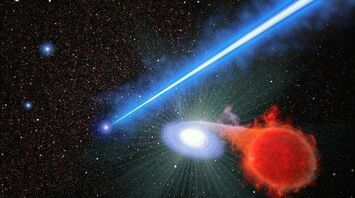Hubble Unveils Black Hole Jet Impact on Nearby Stellar Explosions

NASA’s Hubble Space Telescope has made an astounding discovery. Astronomers have observed that star explosions, or novae, are occurring at double the usual rate in proximity to a massive black hole's jet, compared to other parts of its host galaxy. This phenomenon has left scientists baffled.
A "blowtorch-like" jet from a supermassive black hole, incredibly 6.5 billion times the mass of the sun, located at the galaxy M87’s center, has been identified as the potential cause of these frequent novae. This powerful jet extends a monumental 3,000 light-years through space and includes a trail of fiery plasma. Being caught in this beam could spell disaster for any cosmic object; however, even nearby they face devastation with star systems erupting into novae, yet the exact cause remains a mystery.
Findings and Speculations
These findings, soon to be peer-reviewed, were discussed by astrophysicist Alec Lessing of Stanford University. "This exciting discovery implies a missing aspect in our understanding of black hole jets and their influence on nearby phenomena," Lessing commented in a NASA statement.
Typically located at galaxy centers, supermassive black holes consume surrounding matter, later ejecting it at extreme velocities. This process illuminates the galaxies as material heats up from friction, becoming dramatically luminous. Sometimes, active black holes fashion these inflowing materials into energetic jets, spraying across the universe. However, the local environmental impacts of these jets are not comprehensively understood. By directing Hubble towards the M87 jet, researchers noticed that many more novae were bursting in its vicinity compared to the broader galaxy.
Novas usually ignite in binary star systems when a normal star gifts hydrogen to a white dwarf, igniting thermonuclear explosions equivalent to nuclear bombs. Lessing posed theories about the jet ‘snowplowing’ hydrogen onto these domestic white dwarfs or light pressure from the jet accelerating hydrogen delivery, thereby causing escalated nova activity. Another hypothesis is true if jet material shifts onto the regular companion stars, subsequently depositing on the white dwarfs.
Supporting instruments like Hubble's first-generation Faint Object Camera (FOC) previously observed blue transient events aligning with novae explaining consistent star eruptions. New assessments, with advanced hardware producing comprehensive images from M87, consolidated these earlier cryptic findings, affirming the significant jet influence through extensive statistical analysis.
Astronomers showcased observable novas through nine months of methodological Hubble surveys, revealing 94 near-jet novas in a third of M87’s viewable galaxy. The phenomenon seen directly along the jet stresses extraordinary Hubble’s telescope capabilities far surpassing ground-based telescopes muffled by the black hole's overpowering brightness.
Implications and Operations
Interestingly, nova eruptions, like skyscrapers in a metropolis, populate throughout M87 at near-daily regularity. This astronomical trait emphasizes Hubble's unparalleled capacity to shape our cosmic comprehension, even after more than three decades of innovative findings.
Managed under a collaborative effort between the European Space Agency (ESA) and NASA, Hubble continues to implicate transformative results in astrophysics. NASA’s Goddard Space Flight Center oversees the orchestration, with Lockheed Martin Space supporting operations. Additionally, mission-driven scientific research is coordinated by the Space Telescope Science Institute in Baltimore, Maryland.
Ensuring Hubble's ongoing legacy solidifies the notion that the universe is vibrant with uncharted novae due to black hole jets — each rippling the fabric of the cosmos itself.
Earlier, SSP wrote that scientists transformed giant panda skin cells into stem cells.



















